A Day at Patara Elephant Farm
 Sign at Patara Entrance
Sign at Patara Entrance When we got back from the Thai Elephant Conservation Center in Lampang, we checked into a new hotel. But the very next day my mom and I woke up bright and early. We enjoyed a nice breakfast of tea and fruit while we waited for a van to pick us up. When the van arrived, I saw that printed on the side was a logo that said Patara Elephant Farm. Patara Elephant Farm is a place where you go to be an elephant caretaker for a day. You take care of and bond with the elephant you are assigned.
After we left Chiang Mai, the drive became very scenic. We headed into the mountains. We drove by lush forest and villages. We also passed by something quite interesting. When I was around 2 1/2, our family traveled to Thailand and stayed in a guesthouse in these hills. There we met a little yappy white dog named Rat. Now we passed by this very same guesthouse. I would not be surprised if Rat was still alive today. Down the road from the guesthouse was a family who owned two elephants, a mom and her baby. We would visit them every day. On the day we had to leave, we went to say goodbye to them, but then I refused to get into the taxi to go to the airport, because I wanted to stay with the elephants. We passed by that same place on the drive to Patara, and I could sense the elephants were near. Driving into Patara was magical. I saw elephants roaming around a field and on the hillsides. Mahouts were riding them bareback. We kept driving and we saw more elephants. We got out of the van, and standing before me were six elephants, three of them moms, three of them babies. We met our guide, who was a Karen man named Gao. The Karen people are a hill tribe from this area. Gao first introduced us to the moms and baby elephants.
 Moms and Baby elephants
Moms and Baby elephants The first elephant mom and baby were standing in a little gazebo, eating sugarcane. People sat on the sides of the gazebo and pet the elephants. Gao said that the mom would give us a hug and a kiss, so I volunteered to go first. She came right next to me, lifting her trunk up, and wrapping it around my chest. She then put her wet trunk on my cheek and sucked in. An elephant’s kiss. We all had a good laugh. My mom received the same treatment. Elephant mom and baby number two were very nice, but the baby was very rough. The mahouts called him “Naughty Boy,” because he kept butting people with his hard head, and chased us around. He was truly a naughty boy.
 An elephant's hug
An elephant's hug The last mom and baby stood far away from the gazebo, and this mom was eating sugarcane. Gao told us that we could eat some of her sugarcane, but mom and I were the only ones out of our group who decided to. I did not like the taste of it too much, mostly because it was covered with mud on one side. The elephants did not mind though. This baby was even more playful than the last one. She charged almost everyone she saw, and I had to run away really fast to avoid being knocked over by her. She pulled on my mom’s scarf and tried to teethe on it. I did something that I kind of regret now, but the mahouts asked me to ride on the baby elephant, so I did. I don’t think it hurt her, because I’m only about 31 kg (68 lb), and this elephant was about 150 kg (330 lb). And she might have thought I was just playing with her. It was only for a few seconds, but it was an experience that I will never forget.
Gao then took us up the hill, where we gave the elephant moms some water. We poured the water into the elephants’ trunk until it was full, and then the elephant sprayed it into her mouth. The babies didn't drink at all, but the mahouts played with them by spraying them with water. The babies ran away trumpeting excitedly. After we gave them some water, the moms and their babies walked down the hills with their mahouts.
 Elephant drinking
Elephant drinking We went to a different gazebo, about 200 feet away from the elephant grounds, and we all sat down. We met one of the owners of Patara, named Pat, and he explained to us all about the farm. He talked to us about the elephant population going down in Thailand, and how this park was dedicated to breeding elephants and raising the population. He said this park is different from the others because instead of wanting to show you the elephants and how cute they are so you can just ride them and take photos, here you really get to learn about them and how to help them. You learn about them by spending time and getting to know them. Patara has 32 elephants, mostly moms and babies. The most important thing the owners have to think about is the elephants’ diet and making sure they have enough food. They grow their own food and they also have to buy food from the villagers and the market. Patara is a non-profit organization, and they don’t get money from the government or corporations. All the money they have is from visitors and their donations. They only take very small groups of visitors because a they want to have more elephants than people at the farm. There were 6 other people in our group.
While Pat was talking, we saw two elephants on a little hill about 10 feet away. The younger elephant had her head stuck in a tree, and the older one looked at the younger one disapprovingly. Pat told us that the old one was the younger one’s grandmother. He also said when an elephant loses its mom, another female will come in and adopt the young elephant.
Then we were given Karen mahout ponchos to wear, and we headed down to meet our elephants.
Gao told us the first thing we had to do when approaching our elephant was give them food. He said if you give them food, they will be your friend your whole life. He asked my mom to demonstrate on her elephant, which was a huge, pregnant female named Mae Khwan. He taught us commands in the Karen language to give to the elephant when feeding. “Boun,” means “open your mouth.” You have to say this very sternly and say the elephants name afterward. “Dee dee,” means “good job,” and you pat them on their head to reward them. When you want the elephant to go forward, you hold their ears and say “Ma,” and tug. The elephant will go where you want it to.
While Pat was talking, we saw two elephants on a little hill about 10 feet away. The younger elephant had her head stuck in a tree, and the older one looked at the younger one disapprovingly. Pat told us that the old one was the younger one’s grandmother. He also said when an elephant loses its mom, another female will come in and adopt the young elephant.
Then we were given Karen mahout ponchos to wear, and we headed down to meet our elephants.
Gao told us the first thing we had to do when approaching our elephant was give them food. He said if you give them food, they will be your friend your whole life. He asked my mom to demonstrate on her elephant, which was a huge, pregnant female named Mae Khwan. He taught us commands in the Karen language to give to the elephant when feeding. “Boun,” means “open your mouth.” You have to say this very sternly and say the elephants name afterward. “Dee dee,” means “good job,” and you pat them on their head to reward them. When you want the elephant to go forward, you hold their ears and say “Ma,” and tug. The elephant will go where you want it to.
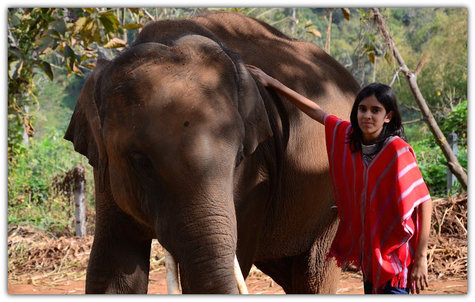 My friend named Puh
My friend named Puh We were assigned our elephant, but Patara does not just randomly assign your elephant. Instead, it is based on your personality and age. I got a young, fit elephant, who was named Puh. He was a sevenyear-old male elephant, and he had tusks. Most of the other people there were in their twenties on their honeymoon, but my mom and I were the only younger and older people. That’s why my mom got the oldest elephant, and I got the youngest. This was a very cool way of assigning your elephant. My elephant, Puh, obviously loved to eat, because he ate about 11 pounds of bananas and sugar cane, and then I dragged him huge bundle of bamboo leaves, which he very quickly ate. He was a very obedient elephant, so I said “dee dee” a lot. Gao then called us back, and he told us we were going to give the elephants a health check. He said there were several steps to this, and some were a bit gross.
If an elephant is healthy, it needs to be wagging his or her tail, and flapping its ears every few minutes. If this is not happening, the elephant is likely stressed or tired. Puh was neither of those things. He was restless. Item of business number two, see if the elephant got a good night’s sleep. A lot of people think that elephants sleep standing up, but that’s not true. An elephant needs to be sleeping down on the side of its body to be healthy and active. So if there is dust on the elephant’s stomach, ears, and cheeks, then you know it’s had a good night’s sleep.
For the next part of the health check up we had to look at the elephant’s eyes. Elephants often look as if they are crying, but they have no tear ducts whatsoever, and their eyes only produce liquid to clean out dirt. But if you see an elephant with one eye more runny than the other, that means that it probably has an infection. But luckily none of the elephants here had any eye problems. The next thing you need to check is the elephant’s sweat. Elephants, like dogs, pant to reduce body temperature, but there is one place on an elephant's body where they do sweat. Above their toenails. We had to check for sweat above our elephant’s toenails. Puh's were very sweaty, which meant he was healthy.
For the next part of the health check up we had to look at the elephant’s eyes. Elephants often look as if they are crying, but they have no tear ducts whatsoever, and their eyes only produce liquid to clean out dirt. But if you see an elephant with one eye more runny than the other, that means that it probably has an infection. But luckily none of the elephants here had any eye problems. The next thing you need to check is the elephant’s sweat. Elephants, like dogs, pant to reduce body temperature, but there is one place on an elephant's body where they do sweat. Above their toenails. We had to check for sweat above our elephant’s toenails. Puh's were very sweaty, which meant he was healthy.
 Smelling the elephant poo
Smelling the elephant poo And finally, we had to check the elephants’ poo. It only takes an elephant two minutes to turn this into that, and we had just fed them, so it was a good time to check the poo. First, you have to see how many pieces the elephant has pooed. If it‘s three or less, then the elephant may have a digestive problem, or maybe ate too little. Puh luckily had seven pieces. Next, you have to pick up the poo, open it up, and check what color it is. You may think it’s kind of gross to pick up dung, but elephant poo is actually very clean because of their short digestion period. What goes in comes out pretty much the same. If the poo is brown, then it is unhealthy, and the elephant probably ate something it wasn't supposed to. But if the poo is a nice lime green color, then it’s healthy. Next, you must take the elephant poo and use your fingers to check the fiber. The more fiber, the healthier the elephant. Then finally, we had to do the juice test. This one I had to do for every piece of Puh's seven pieces. I picked up the poo, wrung out all the juices, and let the greenish pulpy water run down my arm. The more water, the better.
 Brushing Puh
Brushing Puh After the health check, I washed my hands thoroughly. We then had to clean our elephant’s back of dust. The reason we needed to do this was because of mites. Mites will often get stuck under the folds under an elephant’s skin, so a cleaning is not just brushing the back to get the dirt off. You need to brush really hard to brush off those mites. To do this, we got a bunch of bamboo grass tied together, acting as a huge whacker. To get the elephant to lie down, you say, “Nolo.” You say “nolo.” Puh liked the back cleaning, because for him it was like a back scratch. After the cleaning for mites, I gave the brush to Puh, which he gladly ate. We headed over to a concrete circle, where we gave our elephants a shower. The transformation of elephant color is amazing. When an elephant has nothing on its body, it is grey. Some are light grey, some are dark grey. After a dust or mud bath, they turn brown. But when they get wet, they turn pitch black. Some Asian elephants, unlike African elephants, have pink spots on their forehead, trunk, and ears. I used the hose to wash Puh and get every bit of dirt off. This was pretty much useless, because as soon as he got out he threw dirt on his back and rubbed his body in the mud wallow. But it was time for lunch, so we said bye to the elephants, but we told them we’d be back in an hour.
Our lunch was very nice. When we got back to the gazebo, there was a huge banana leaf covering something on the table. Whatever it was, it smelled amazing. When Gao pulled off the banana leaf, on the table lay fried chicken, grilled pork, about a jillion types of fruit, sticky rice, and Thai donuts. Even the cats who walked around thought it was good. They kept begging for some of the meat that was lying on the table.
After lunch, we changed into our bathing suits and headed back to our elephants. We were now going to ride the elephants bareback on their necks, a process that does not hurt the elephant. At Patara they don’t think heavy elephant saddle, or, “howdah,” is good for the elephant, but they have nothing against riding elephants bareback. They said it’s only okay to ride on the neck, because if you ride on the back your legs dangle in the way of the leg joints, making it hard for the elephant to walk.
Gao told us there were three ways to get on an elephant. For the first way, the elephant raises one foot slightly, you put one foot on the elephant’s foot, the other on the elephant’s leg, you hoist yourself atop the elephant back, and then you scoot up to the neck. This is what I did. The second way is for the elephant to lie down completely, and you get on to the back from there. The third way is the elephant brings his head down, and you step lightly on the upper trunk, and when the elephant lifts its head up, you scoot up to the neck. My mom did it this way, but she got stuck on the way up. My mom was suspended on Mae Khwan’s forehead. She eventually got on the neck, but she was facing backwards, and struggled the whole way around to face forward. When she did, everyone cheered.
Gao told us there were three ways to get on an elephant. For the first way, the elephant raises one foot slightly, you put one foot on the elephant’s foot, the other on the elephant’s leg, you hoist yourself atop the elephant back, and then you scoot up to the neck. This is what I did. The second way is for the elephant to lie down completely, and you get on to the back from there. The third way is the elephant brings his head down, and you step lightly on the upper trunk, and when the elephant lifts its head up, you scoot up to the neck. My mom did it this way, but she got stuck on the way up. My mom was suspended on Mae Khwan’s forehead. She eventually got on the neck, but she was facing backwards, and struggled the whole way around to face forward. When she did, everyone cheered.
 Riding Puh in the jungle
Riding Puh in the jungle Up on the elephant was really high. When I looked down, I felt a bit scared of falling off, but my mom was on an elephant 3 feet taller than mine. Yikes. Gao told us some commands for the elephant when riding. “Pai,” means “go forward.” “How,” was “stop.” You had to say “dee dee” a lot to let the elephant know he was doing a good job. “Janna,” was very important. It means “do not eat that,” because the elephants would constantly eat during the walk, stopping the elephants behind them from moving, and some plants aren't good for them. When we learned all these commands, we said “Pai,” and we were off into the little forest. The elephant ride was about 1 hour. I prefer this to riding in a car any day. The elephants were slow, calm, and made journey so much more interesting. On the ride one of the baby elephants that followed the elders ran around, knocking over small trees and uprooting them like it was nothing. In some places the hillside was very steep, and some trees were hard to squeeze through. The height of the elephant helped me reach up in the trees and get a nice ripe branch of leaves for Puh. At the bottom of the hill, there was a road we had to cross to get to the river. The mahouts directed the traffic, and when the elephants crossed all the cars had to stop. I waved to people in their cars from on top of Puh.
When we got off our elephant, my legs were sore and stiff. We left the elephants with the mahouts for a while, while Gao showed us to the river. A different group was with their elephants, washing them and splashing them, and we watched them take a group photo. While their backs were turned, the elephants sprayed them with water. Now we knew what was to come. I dipped my foot in the water, and it was freezing cold. My mahout and Puh were already in the water like it was nothing. After getting used to the water it was not that cold. My mahout told me to get on Puh’s back and start scrubbing behind his ears. But as soon as I got on his back, he turned over and lay on his side under water, which pulled me neck deep in the water. Puh was very playful in the water, and he would spray me and pull me under water. I washed his head, eyes, tail, and even his tusks. I took some sand and rubbed it up and down his tusks, making them gleam like marble. Being in the water with the elephants was the most fun I’ve had in a long time. And sure enough, the elephants sprayed us with water at the end.
It was time for us to leave, but before we left we had a four-minute elephant ride to the van pick up. I thanked my mahout very much, and gave Puh a big hug and kiss. I would miss him, but I’m going to come back next year. Gao gave us a DVD with all the pictures on it. It had been a great experience that we will have again. But our Thai elephant expedition was not over yet. We still had one more sanctuary to go to. As we drove back to Chiang Mai, I saw all of the elephants waving at me, and I saw Puh giving me a huge smile.

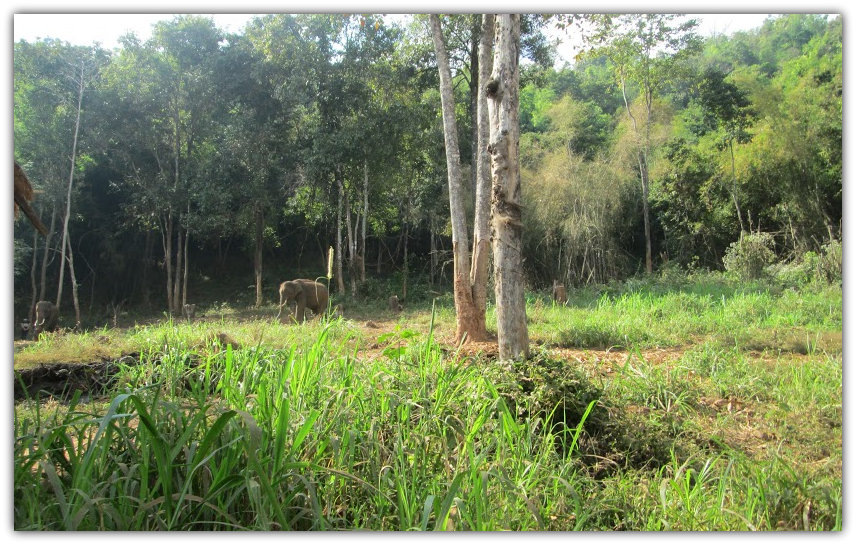

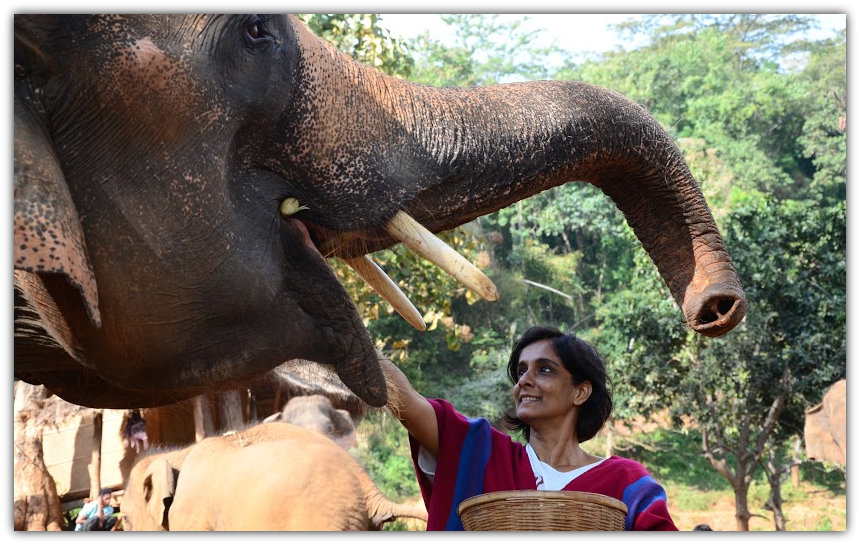






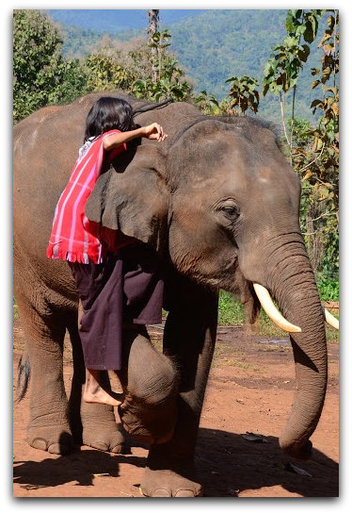

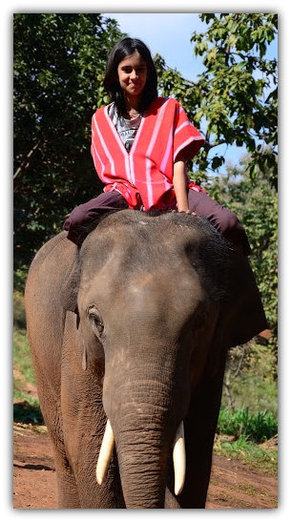





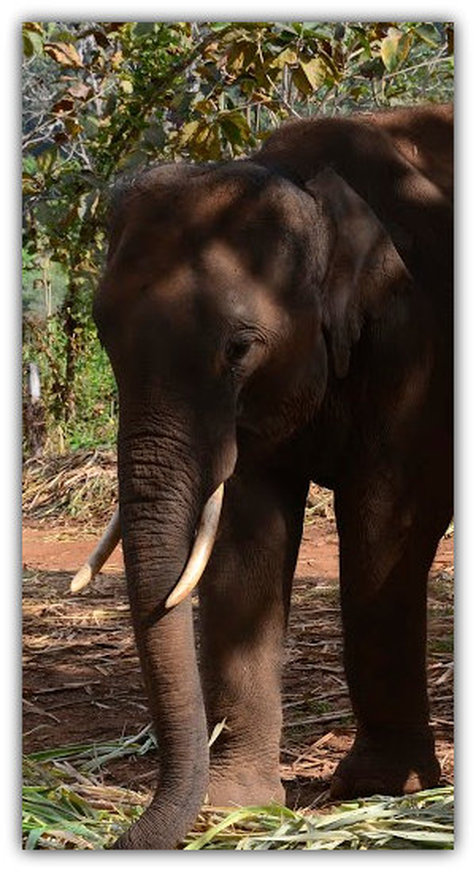




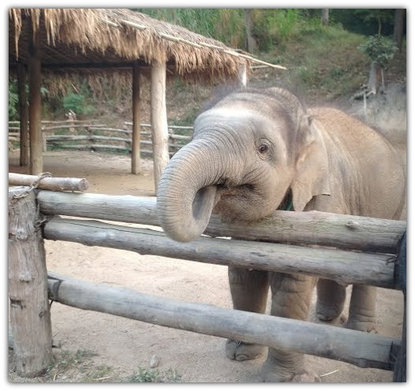
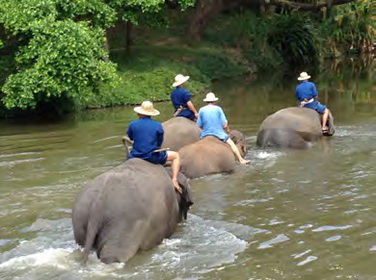


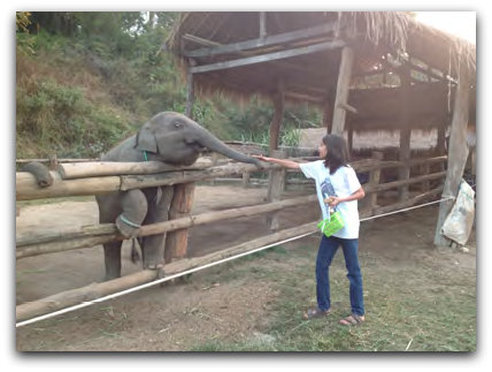


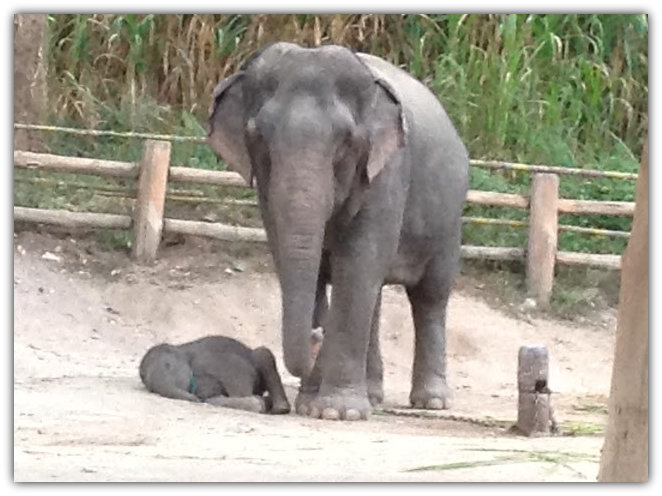




 RSS Feed
RSS Feed


